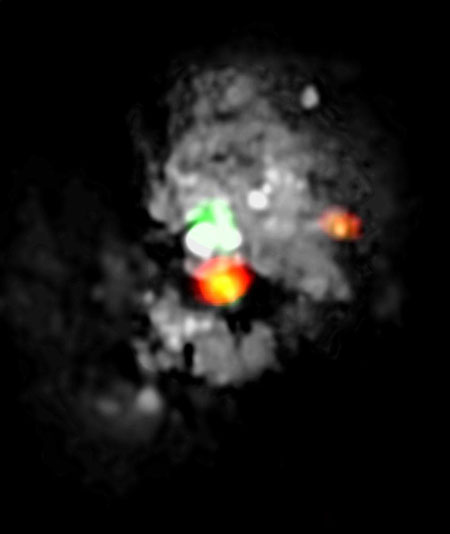| Jun 16, 2015 |
NOEMA takes a look into a distant stellar delivery room
|
|
(Nanowerk News) Astronomers have succeeded in recording the first image with the most sensitive millimetre radio telescope in the northern hemisphere: The installation known as NOEMA provided a spectacular image of a previously unknown region of massive star formation in the Medusa Merger – a brightly shining pair of colliding of galaxies. The object is more than 100 million light years away from Earth. The Northern Extended Millimeter Array is located on the Plateau de Bure in the French High Alps and operated by the Institut de Radioastronomie Millimétrique (IRAM).
|
 |
| A look into the unknown: Scientists have found a previously unexplored region of massive star formation in the Medusa Merger (NGC 4194) with the help of the NOEMA observatory. The image, which contains observations made with NOEMA and with the Hubble Space Telescope, shows the “Eye of Medusa” (orange), which is located directly below the centre of NGC 4194 (here white and green), a pair of colliding galaxies. (Image: IRAM/NASA/ESA Hubble Space Telescope, Hubble Legacy Archive) (click on image to enlarge)
|
|
NOEMA is one of a new generation of radio telescopes and is already – four years before it is fully completed – the most powerful and most sensitive radio telescope in the millimetre range in the northern hemisphere. NOEMA currently consists of seven 15-metre dish antennae, each equipped with a high-sensitivity receiver system.
|
|
Over the next four years, NOEMA will multiply its observational powers in terms of spatial resolution and sensitivity. With a total of twelve dishes, NOEMA will then afford researchers an unusually detailed look into space.
|
|
On the first image, the scientists discovered an unknown region of massive star formation which is located within a colliding pair of galaxies known as the Medusa Merger. In fact, the observations have unearthed a huge region extending over more than 500 light years and densely populated with young, newly formed stars. Shrouded as they are by the cosmic gas and dust clouds in whose interior they were formed, these stars remain invisible to optical telescopes.
|
|
Moreover, none of the earlier observations at other wavelengths was able to shed any light on what is actually happening behind the impenetrable veil of clouds of the Medusa Merger. Despite all efforts, this spectacular region called the “Eye of Medusa” remained hidden from view. Thanks to the NOEMA dishes, which can detect the molecules hydrocyanic acid (HCN) and the formyl cation (HCO+), the astronomers were now to look into the hidden region of the “Eye of Medusa” for the first time.
|
|
“I cannot even begin to describe our astonishment when we saw how this region lit up from one minute to the next and suddenly shone in the light of thousands of stars,” says project head Sabine König. “It even turned out,” adds the IRAM researcher, “that this is the most active region of star formation in the whole structure, which was formed by the interaction of the two galaxies – virtually a gigantic nursery for stars!”
|
|
The scientific analysis of the interactions between galaxies and their concrete effects on star formation is crucial for understanding the evolution of galaxies and the universe overall.
|
|
Roberto Neri, scientific director of the NOEMA observatory, expresses his satisfaction: “These observations prove that we can fully exploit the capabilities of our new instrument.” In the years to come, NOEMA’s high power will make a key contribution to studying the processes of star formation itself in distant regions of space.
|

